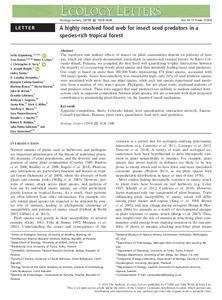A highly resolved food web for insect seed predators in a species-rich tropical forest
Sofia Gripenberg; Yves Basset; Owen T. Lewis; J. Christopher D. Terry; S. Joseph Wright; Indira Simón; D. Catalina Fernández; Marjorie Cedeño-Sanchez; Marleny Rivera; Héctor Barrios; John W. Brown; Osvaldo Calderón; Anthony I. Cognato; Jorma Kim; Scott E. Miller; Geoffrey E. Morse; Sara Pinzón-Navarro; Donald L. J. Quicke; Robert K. Robbins; Juha-Pekka Salminen; Eero Vesterinen
A highly resolved food web for insect seed predators in a species-rich tropical forest
Sofia Gripenberg
Yves Basset
Owen T. Lewis
J. Christopher D. Terry
S. Joseph Wright
Indira Simón
D. Catalina Fernández
Marjorie Cedeño-Sanchez
Marleny Rivera
Héctor Barrios
John W. Brown
Osvaldo Calderón
Anthony I. Cognato
Jorma Kim
Scott E. Miller
Geoffrey E. Morse
Sara Pinzón-Navarro
Donald L. J. Quicke
Robert K. Robbins
Juha-Pekka Salminen
Eero Vesterinen
WILEY
Julkaisun pysyvä osoite on:
https://urn.fi/URN:NBN:fi-fe2021042824814
https://urn.fi/URN:NBN:fi-fe2021042824814
Tiivistelmä
The top-down and indirect effects of insects on plant communities depend on patterns of host use, which are often poorly documented, particularly in species-rich tropical forests. At Barro Colorado Island, Panama, we compiled the first food web quantifying trophic interactions between the majority of co-occurring woody plant species and their internally feeding insect seed predators. Our study is based on more than 200 000 fruits representing 478 plant species, associated with 369 insect species. Insect host-specificity was remarkably high: only 20% of seed predator species were associated with more than one plant species, while each tree species experienced seed predation from a median of two insect species. Phylogeny, but not plant traits, explained patterns of seed predator attack. These data suggest that seed predators are unlikely to mediate indirect interactions such as apparent competition between plant species, but are consistent with their proposed contribution to maintaining plant diversity via the Janzen-Connell mechanism.
Kokoelmat
- Rinnakkaistallenteet [27094]
